Viral Vector & Plasmid DNA Manufacturing Market Size
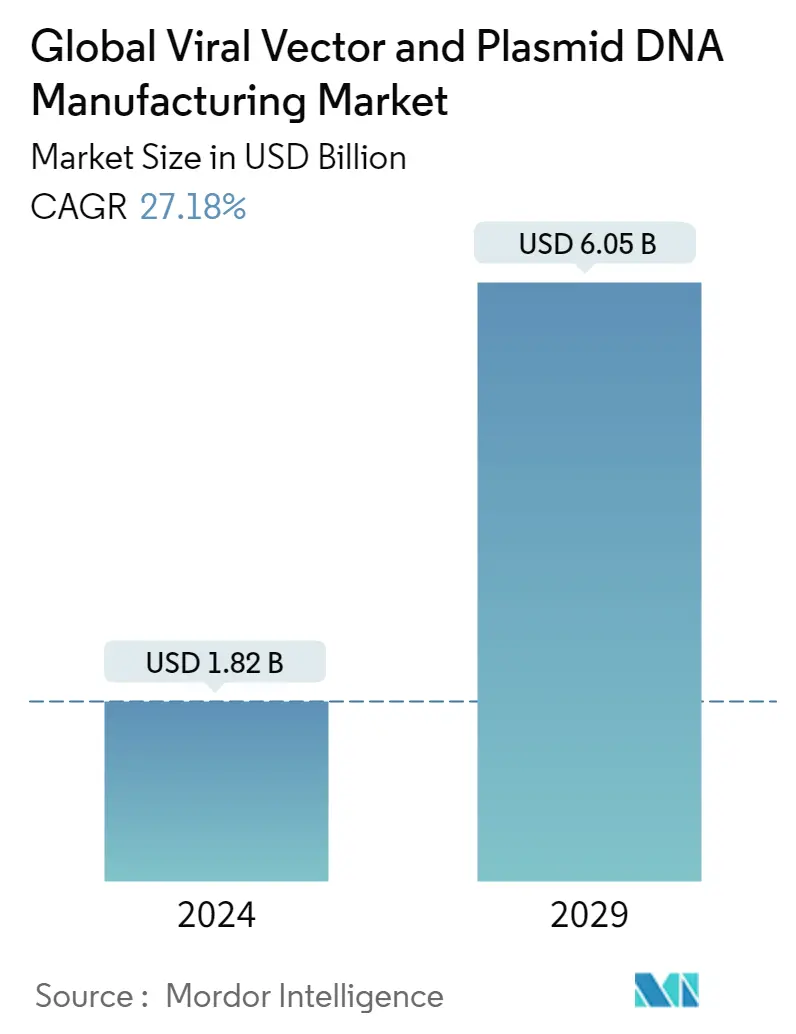
| Study Period | 2019 - 2029 |
| Market Size (2024) | USD 1.82 Billion |
| Market Size (2029) | USD 6.05 Billion |
| CAGR (2024 - 2029) | 27.18 % |
| Fastest Growing Market | Asia Pacific |
| Largest Market | North America |
Major Players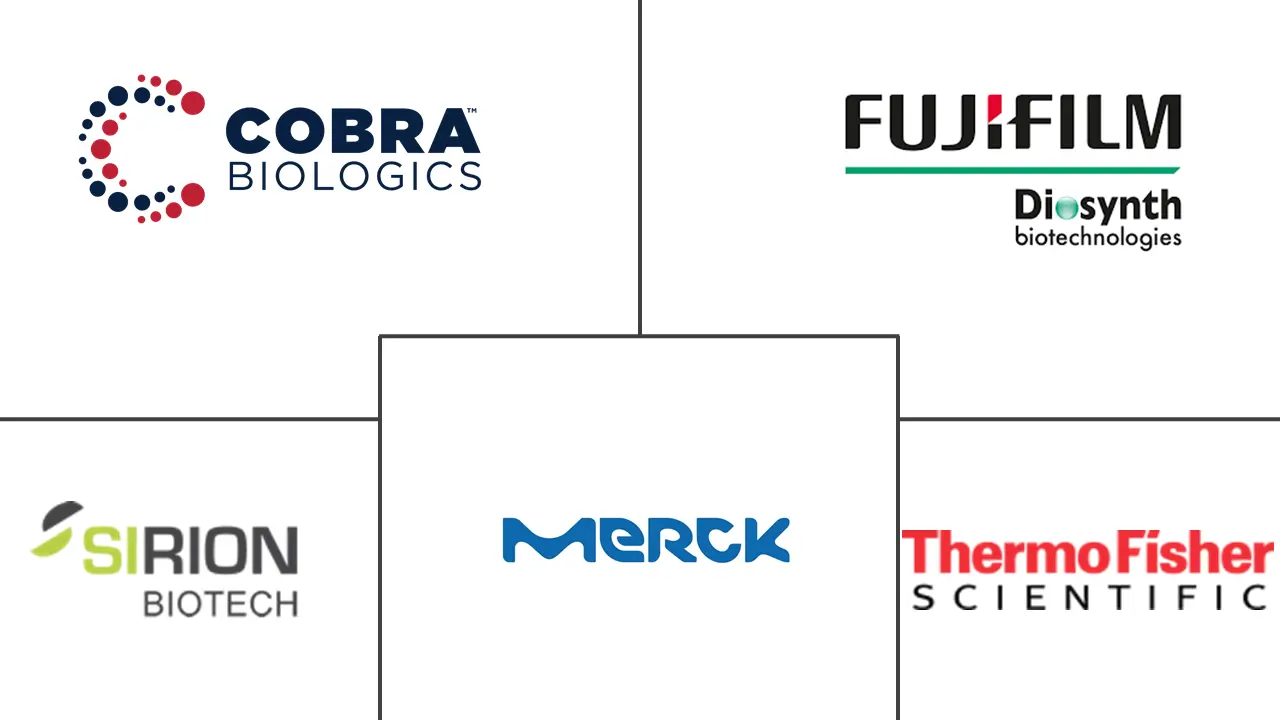
*Disclaimer: Major Players sorted in no particular order |
Viral Vector & Plasmid DNA Manufacturing Market Analysis
The Global Viral Vector and Plasmid DNA Manufacturing Market size is estimated at USD 1.82 billion in 2024, and is expected to reach USD 6.05 billion by 2029, growing at a CAGR of 27.18% during the forecast period (2024-2029).
The COVID-19 outbreak is expected to positively impact the viral vector and plasmid DNA manufacturing market. Several COVID-19 vaccine candidates entering clinical trials also include viral vector vaccines. These vaccines are likely to be among the COVID-19 vaccines authorized for use worldwide. Many of them have also received or are in the final stages of receiving approval. In January 2021, Johnson & Johnson announced favorable efficacy and safety data from its Phase 3 ENSEMBLE clinical trial using its AdVac vaccine platform for COVID-19. Its single-dose COVID-19 vaccine, currently under development at its Janssen Pharmaceutical Companies, met all preconditions and targets. The AdVac viral vector technology could provide a potent and long-lasting humoral and cellular immune response to the body. Another viral vector-based vaccine, which has received several approvals, is the Oxford-AstraZeneca COVID-19 vaccine. The vaccine was first discovered in November 2020 and has since been mass-produced to vaccinate people. The COVID-19 viral vector vaccines are under development worldwide using non-replicating viral vectors. The immune response of these vaccines follows a similar pattern, i.e., it includes antibody-producing B cells and T cells, which seek out and destroy infected cells in the body, providing long-lasting immunity. Further research and increased investment in this field are expected to positively affect vaccine development.
Demand for plasmid DNA is growing steadily due to growth in gene therapy development. pDNA is a prerequisite for producing AAV (adeno-associated virus), lentivirus, and other viral vector platforms. There is also an increase in several genetic disorders and numerous life-threatening disorders, especially heart diseases, AIDS, cystic fibrosis, and age-related disorders. For instance, as per the Centers for Disease Control and Prevention, 2021, hypertension, or high blood pressure, is a leading risk factor for cardiovascular disease and causes an estimated 10 million deaths worldwide each year. These statistics represent 35% of global deaths. Gene therapy with viral vectors provides a complete cure to patients suffering from genetic disorders and other life-threatening disorders rather than ease symptoms with other treatments. Several clinical studies are being conducted on viral vectors and plasmid DNA manufacturing, emphasizing the potential of gene therapy to address important medical needs.
Several players, including pharmaceutical companies, contract manufacturing organizations, research institutes, and non-profit organizations, are playing a critical role in the development and production of these vectors. In April 2021, ViroCell Biologics, the UK clinical trial-focused viral vector manufacturer, launched its viral vectors. Through this launch, the company will supply viral vectors and gene-modified cells to academic and corporate clients for translational cell and gene therapies going into clinical trials.
Viral Vector & Plasmid DNA Manufacturing Market Trends
This section covers the major market trends shaping the Viral Vector & Plasmid DNorth America Manufacturing Market according to our research experts:
By Application, Cancer Segment is Expected to Register Robust Growth.
The upsurge in the global incidence of cancer and modern healthcare facilities are acting as major drivers for the segment growth. According to GLOBOCAN 2020, there were 1,92,92,789 new cancer cases in 2020, and it is projected to increase to 2,88,87,940 cases by 2040.. Additionally, there are also many gene therapy strategies that have been developed to treat a wide range of cancers, including suicide gene therapy, oncolytic virotherapy, anti-angiogenesis, and therapeutic gene vaccines.
According to a 2019 research article 'Chemovirotherapeutic Treatment Using Camptothecin Enhances Oncolytic Measles Virus-Mediated Killing of Breast Cancer Cells', oncolytic virotherapy represents an emerging development in anticancer therapy. Although it has been tested against a variety of cancers, including breast cancer, the efficacy of oncolytic viral vectors delivered as monotherapy is limited. Oncolytic virotherapy is a promising treatment that selectively targets and destroys cancer tissues with minimal damage to normal cells.
Currently, there are numerous Phase I and Phase II clinical trials related to viral vectors for the treatment of various types of cancers, such as brain, skin, liver, colon, breast, and kidney, among others, which are being conducted in academic centers and biotechnology companies.
Moreover, gene therapy based on viral vectors has established steady progress in the area of cancers recently. There is a mass of viral vectors that have been engineered for both preventive and therapeutic applications. Market players are also adopting various market strategies in developing novel products.
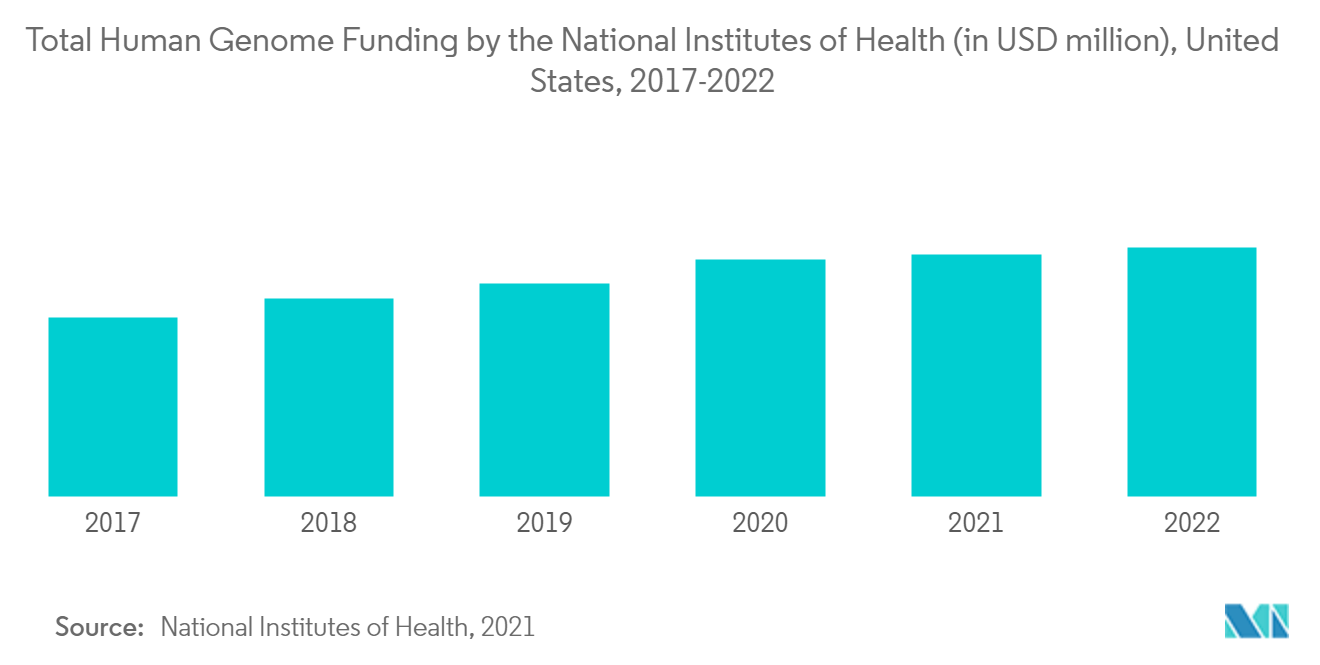
North America Dominated the Market in Terms of Revenue Generated
Currently, the North American viral vector and plasmid DNA manufacturing market is witnessing rapid growth. Companies in the region are innovating new product approaches for viral vectors. For example, in April 2018, United States-based GE Healthcare created a 'factory-in-a-box' facility to produce viral vector-based drugs, including viral vector vaccines, oncolytic viruses, and gene and cell therapies. Many companies are also increasing their production facilities. For example, in January 2020, Genopis Inc. announced to build a contract manufacturing business for plasmid DNA production in the United States with its South Korea-based partner Helixmith. In January 2021, United States-headquartered Cobra Biologics, the gene therapy division of the Cognate BioServices Group, announced that it had begun a multi-phase increase in its plasmid DNA services as a continuation of its gene therapy services' expansion project for viral vectors and plasmid DNA.
Gene therapy in Canada is also rising rapidly. It is used for the treatment of various diseases. For instance, Kymriah was the first gene therapy product approved in Canada in September 2018 for treating cancer. Health Canada approved Novartis Kymriah for pediatric, young adult, and adult patients.
In February 2019, Health Canada also approved another gene therapy product called Yescarta, manufactured by Kite Pharmaceuticals for an aggressive kind of non-Hodgkins lymphoma. Viral vector design and manufacturing control are critically important for the overall product quality, safety, and efficiency in patients through concerns such as replication competence, vector integration, and vector shedding. There are significant advancements in developing novel viral vectors, and several researchers are focusing on substituting pathogenic genes with therapeutic DNA. Nowadays, non-pathogenic, replication-defective, and human-friendly viral vectors are being widely used in clinical trials for gene therapy. As more research is expected to be conducted on viral vectors and plasmid DNA, these developments may positively impact market growth.
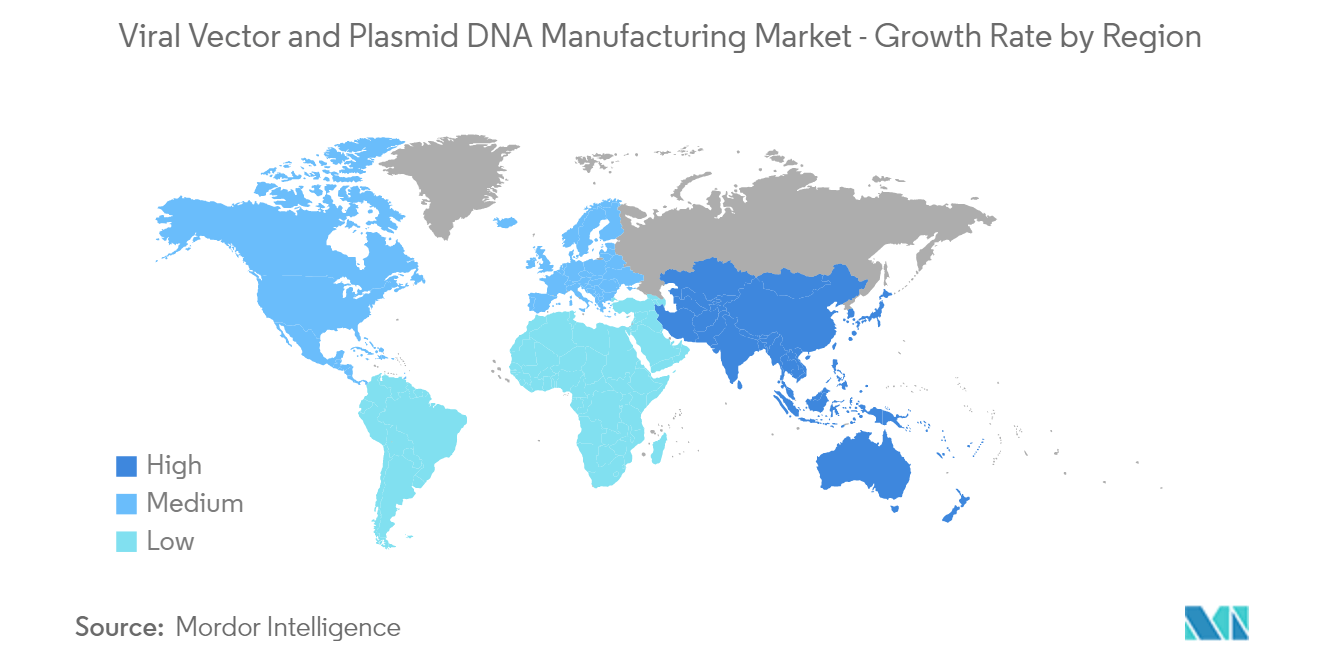
Viral Vector & Plasmid DNA Manufacturing Industry Overview
The market is still in the nascent stage. Hence, increasing focus is mainly on the development of innovative products. Key market players include Cobra Biologics, Fujifilm Diosynth Biotechnologies, SIRION Biotech, Merck KGaA Inc., and Thermo Fisher Scientific.
Various strategies, such as research and development, mergers and acquisitions, and product launches, are being adopted by domestic companies to strengthen their market position. In December 2020, CHA Biotech signed a lease agreement with Matica Bio to construct a viral vector production facility in College Station, Texas. The construction of the 25,000 sq. ft facility started in Q4 2020. It is expected to be dedicated to producing viral vectors used in cell and gene therapies, vaccines, and oncolytic products. It was scheduled to open in Q3 2021.
Viral Vector & Plasmid DNA Manufacturing Market Leaders
-
Fujifilm Diosynth Biotechnologies
-
SIRION Biotech
-
Thermo Fisher Scientific
-
Merck KGaA Inc.
-
Cognate BioServices Inc. (Cobra Biologics)
*Disclaimer: Major Players sorted in no particular order
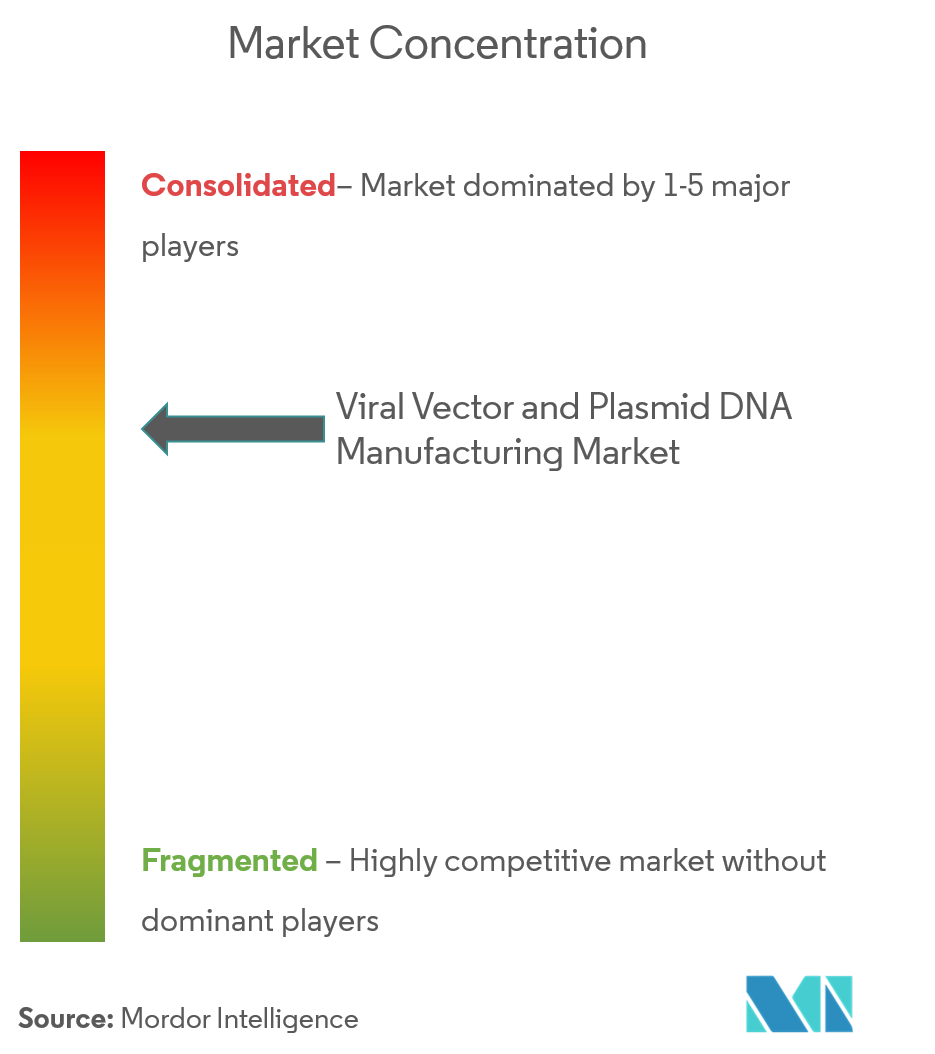
Viral Vector & Plasmid DNA Manufacturing Market News
- In July 2021, the company Thermo Fisher Scientific Inc. announced the launch of new cGMP plasmid DNA manufacturing facility in Carlsbad, Calif which will full fill the growing demand of plasmid DNA-based therapies and vital mRNA-based vaccines.
- In February 2021, Wacker announced the acquisition of the United States-based Genopis Inc., a major manufacturer of plasmid DNA in the United States.
- In June 2020, Aldevron announced a collaboration with Ziopharm Oncology to help produce plasmid DNA for T cell therapy of solid tumors.
Viral Vector & Plasmid DNA Manufacturing Market Report - Table of Contents
1. INTRODUCTION
- 1.1 Study Assumptions and Market Definition
- 1.2 Scope of the Study
2. RESEARCH METHODOLOGY
3. EXECUTIVE SUMMARY
4. MARKET DYNAMICS
- 4.1 Market Overview
-
4.2 Market Drivers
- 4.2.1 Rising Prevalence of Genetic Disorders, Cancer, and Infectious Diseases
- 4.2.2 Increasing Number of Clinical Studies and Availability of Funding for Gene Therapy Development
- 4.2.3 Potential Applications in Novel Drug Delivery Approaches
-
4.3 Market Restraints
- 4.3.1 High Cost of Gene Therapies
- 4.3.2 Challenges in Viral Vector Manufacturing Capacity
-
4.4 Porter's Five Forces Analysis
- 4.4.1 Threat of New Entrants
- 4.4.2 Bargaining Power of Buyers/Consumers
- 4.4.3 Bargaining Power of Suppliers
- 4.4.4 Threat of Substitute Products
- 4.4.5 Intensity of Competitive Rivalry
5. MARKET SEGMENTATION (Market Size by Value - USD million)
-
5.1 By Product Type
- 5.1.1 Plasmid DNA
- 5.1.2 Viral Vector
- 5.1.3 Non-viral Vector
-
5.2 By Application
- 5.2.1 Cancer
- 5.2.2 Genetic Disorder
- 5.2.3 Infectious Disease
- 5.2.4 Other Applications
-
5.3 Geography
- 5.3.1 North America
- 5.3.1.1 United States
- 5.3.1.2 Canada
- 5.3.1.3 Mexico
- 5.3.2 Europe
- 5.3.2.1 United Kingdom
- 5.3.2.2 Germany
- 5.3.2.3 France
- 5.3.2.4 Italy
- 5.3.2.5 Spain
- 5.3.2.6 Rest of Europe
- 5.3.3 Asia-Pacific
- 5.3.3.1 China
- 5.3.3.2 Japan
- 5.3.3.3 India
- 5.3.3.4 Australia
- 5.3.3.5 South Korea
- 5.3.3.6 Rest of Asia-Pacific
- 5.3.4 Middle-East and Africa
- 5.3.4.1 GCC
- 5.3.4.2 South Africa
- 5.3.4.3 Rest of Middle-East and Africa
- 5.3.5 South America
- 5.3.5.1 Brazil
- 5.3.5.2 Argentina
- 5.3.5.3 Rest of South America
6. COMPETITIVE LANDSCAPE
-
6.1 Company Profiles
- 6.1.1 Oxford Biomedica
- 6.1.2 Cognate BioServices Inc. (Cobra Biologics)
- 6.1.3 Cell and Gene Therapy Catapult
- 6.1.4 FinVector Vision Therapies
- 6.1.5 Fujifilm Holdings Corporation (Fujifilm Diosynth Biotechnologies)
- 6.1.6 MassBiologics
- 6.1.7 SIRION Biotech
- 6.1.8 Merck KGaA Inc.
- 6.1.9 Thermo Fisher Scientific
- 6.1.10 Uniqure NV
- 6.1.11 Catalent Inc.
- *List Not Exhaustive
7. MARKET OPPORTUNITIES AND FUTURE TRENDS
** Subject To AvailablityViral Vector & Plasmid DNA Manufacturing Industry Segmentation
As per the scope of the report, viral vectors and plasmid DNA are the products of gene therapy used for the treatment of several diseases, such as Alzheimer's disease, Parkinson's disease, and rheumatoid arthritis. Gene therapies and other therapies that require genetic modification include the introduction of therapeutic DNA/genes into a patient's body or cell by using vectors. Over the past few decades, various viral and non-viral vectors have been developed and standardized for this purpose. Viral vectors and plasmid DNA are known to reduce the cost of treatment and help in decreasing repeated administration of medications.
The market is segmented by product type (plasmid DNA, viral vector, and non-viral vector), application (cancer, genetic disorder, infectious disease, and other applications), and geography (North America, Europe, Asia-Pacific, Middle-East and Africa, and South America). The report offers the value in USD million for the above segments.
| By Product Type | Plasmid DNA | |
| Viral Vector | ||
| Non-viral Vector | ||
| By Application | Cancer | |
| Genetic Disorder | ||
| Infectious Disease | ||
| Other Applications | ||
| Geography | North America | United States |
| Canada | ||
| Mexico | ||
| Geography | Europe | United Kingdom |
| Germany | ||
| France | ||
| Italy | ||
| Spain | ||
| Rest of Europe | ||
| Geography | Asia-Pacific | China |
| Japan | ||
| India | ||
| Australia | ||
| South Korea | ||
| Rest of Asia-Pacific | ||
| Geography | Middle-East and Africa | GCC |
| South Africa | ||
| Rest of Middle-East and Africa | ||
| Geography | South America | Brazil |
| Argentina | ||
| Rest of South America |
Viral Vector & Plasmid DNA Manufacturing Market Research FAQs
How big is the Global Viral Vector and Plasmid DNA Manufacturing Market?
The Global Viral Vector and Plasmid DNA Manufacturing Market size is expected to reach USD 1.82 billion in 2024 and grow at a CAGR of 27.18% to reach USD 6.05 billion by 2029.
What is the current Global Viral Vector and Plasmid DNA Manufacturing Market size?
In 2024, the Global Viral Vector and Plasmid DNA Manufacturing Market size is expected to reach USD 1.82 billion.
Who are the key players in Global Viral Vector and Plasmid DNA Manufacturing Market?
Fujifilm Diosynth Biotechnologies, SIRION Biotech, Thermo Fisher Scientific, Merck KGaA Inc. and Cognate BioServices Inc. (Cobra Biologics) are the major companies operating in the Global Viral Vector and Plasmid DNA Manufacturing Market.
Which is the fastest growing region in Global Viral Vector and Plasmid DNA Manufacturing Market?
Asia Pacific is estimated to grow at the highest CAGR over the forecast period (2024-2029).
Which region has the biggest share in Global Viral Vector and Plasmid DNA Manufacturing Market?
In 2024, the North America accounts for the largest market share in Global Viral Vector and Plasmid DNA Manufacturing Market.
What years does this Global Viral Vector and Plasmid DNA Manufacturing Market cover, and what was the market size in 2023?
In 2023, the Global Viral Vector and Plasmid DNA Manufacturing Market size was estimated at USD 1.43 billion. The report covers the Global Viral Vector and Plasmid DNA Manufacturing Market historical market size for years: 2019, 2020, 2021, 2022 and 2023. The report also forecasts the Global Viral Vector and Plasmid DNA Manufacturing Market size for years: 2024, 2025, 2026, 2027, 2028 and 2029.
Viral Vectors and Plasmid DNA Manufacturing Industry Report
The report on Global Plasmid DNA Manufacturing Companies and Market Segmentation by Product Type, Application, and Geography provides a comprehensive analysis of market size, market share, and market growth. The report includes an industry overview and market forecast outlook, offering insights into market trends and market leaders. The market report highlights significant market data, market segmentation, and market value, providing an in-depth industry analysis and market review.
The industry reports cover various aspects of the market, including industry information, industry outlook, and industry research. The report also includes industry statistics, industry sales, and industry size, giving a detailed view of the market predictions and market outlook. The industry analysis delves into the growth rate and market forecast, ensuring a thorough understanding of the market dynamics.
Additionally, the report example and report PDF offer valuable insights into market predictions and market trends. The industry research companies have compiled this report to provide a detailed market review, focusing on market segmentation and market value. The market leaders and market growth are highlighted, ensuring that the report covers all essential aspects of the industry.
The report summary is based on the latest industry statistics and industry trends, providing a clear market overview. The market data and market forecast are meticulously analyzed to offer accurate market predictions and market outlook. The industry analysis and industry research ensure that the report is comprehensive and informative, making it a valuable resource for understanding the market dynamics and market trends.



